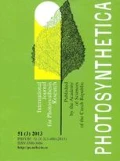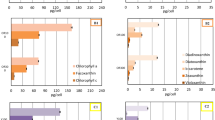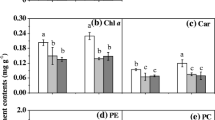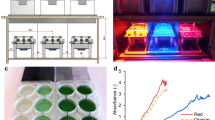Abstract
Chrococcoid cyanobacteria of the genus Synechococcus are the important component of marine and freshwater ecosystems. Picocyanobacteria comprise even 80% of total cyanobacterial biomass and contribute to 50% of total primary cyanobacterial bloom production. Chlorophyll (Chl) fluorescence and photosynthetic light response (P-I) curves are commonly used to characterize photoacclimation of Synechococcus strains. Three brackish, picocyanobacterial strains of Synechococcus (BA-132, BA-124, BA-120) were studied. They were grown under 4 irradiances [10, 55, 100, and 145 μmol(photon) m−2 s−1] and at 3 temperatures (15, 22.5, and 30°C). Photosynthetic rate was measured by Clark oxygen electrode, whereas the Chl fluorescence was measured using Pulse Amplitude Modulation fluorometer. Based on P-I, two mechanisms of photoacclimation were recognized in Synechococcus. The maximum value of maximum rate of photosynthesis (P max) expressed per biomass unit at 10 μmol(photon) m−2 s−1 indicated a change in the number of photosynthetic units (PSU). The constant values of initial slope of photosynthetic light response curve (α) and the maximum value of P max expressed per Chl unit at 145 μmol(photon) m−2 s−1 indicated another mechanism, i.e. a change in PSU size. These two mechanisms caused changes in photosynthetic rate and its parameters (compensation point, α, saturation irradiance, dark respiration, P max) upon the influence of different irradiance and temperature. High irradiance had a negative effect on fluorescence parameters, such as the maximum quantum yield and effective quantum yield of PSII photochemistry (φPSII), but it was higher in case of φPSII.
Similar content being viewed by others
Abbreviations
- ANOVA :
-
analysis of variance
- CCBA:
-
Culture Collection of Baltic Algae
- Chl:
-
chlorophyll
- I K :
-
saturation irradiance
- FV/FM :
-
maximum quantum yield of PSII photochemistry
- N:
-
number of cells
- OD:
-
optical density
- PAR:
-
photosynthetically active radiation
- PAM:
-
Pulse Amplitude Modulation
- CP:
-
compensation point
- P-I :
-
photosynthetic light response
- P max :
-
maximum photosynthetic rate
- P N :
-
net photosynthetic rate
- PSU:
-
photosynthetic units
- R D :
-
dark respiration rate
- TEM:
-
transmission electron microscope
- ΦPSII :
-
effective quantum yield of PSII photochemistry
- α:
-
initial slope of photosynthetic light response curve
References
Albertano, P., Di Somma, D., Capucci, E.: Cyanobacterial picoplankton from the Central Baltic Sea: cell size classification by image-analyzed fluorescence microscopy. — J. Plankton Res. 19: 1405–1416, 1997.
Antia, N.J.: Effects of temperature on the darkness survival of marine microplanktonic algae. — Microb. Ecol. 3: 41–54, 1976.
Björkman, O., Demmig, B.: Photon yield of O2 evolution and chlorophyll fluorescence characteristics at 77K among vascular plants of diverse origins. — Planta 170: 489–504, 1987.
Blackburn, S.I., McCausland, M.A., Bolch, C.J.S., Newman, S.J., Jones, G.J.: Effect of salinity and toxin production in cultures of the bloom-forming cyanobacterium Nodularia spumigena from Australian waters. — Phycologia 35: 511–522, 1996.
Callieri, C., Moro, S., Caravati, E., Crosbie, N.D., Weisse, T.: Strain-specific photosynthetic response of freshwater picocyanobacteria. — Verh. Internat. Verein. Limnol. 29: 777–782, 2005.
Campbell, D., Hurry, V., Clarke, A.K., Gustafsson, P., Öquist, G.: Chlorophyll fluorescence analysis of cyanobacterial photosynthesis and acclimation. — Microbiol. Mol. Biol. R. 62: 667–683, 1998.
Defew, E.C., Perkins, R.G., Paterson, D.M.: The influence of light and temperature interactions on a natural estuarine microphytobenthic assemblage. — Biofilms 1: 21–30, 2004.
Dring, M.J.: The Biology of Marine Plants. 199 pp. Cambridge Univ. Press, Cambridge 1998.
Dubinsky, A., Stambler, N.: Photoacclimation processes in phytoplankton: mechanisms, consequences, and applications. — Aquat. Microb. Ecol. 56: 163–176, 2009.
Fisher, R.A., Yates, F.: Statistical Tables for Biological, Agricultural and Medical Research. 6th ed. 138 pp. Olivier and Boyd, Edinburgh 1963.
Fogg, G.E.: Ocean ecology: Light and Ultraphytoplankton. 99 pp. Nature Publishing Group, London 1986.
Fogg, G.E., Thake, B.: Algal Cultures and Phytoplankton Ecology. 269 pp. University of Wisconsin Press, Madison and Milwaukee 1987.
Glover, H. E., Phinney, D.A., Yentsch, C.S.: Photosynthetic characteristics of picoplankton compared with those of larger phytoplankton populations, in various water masses in the Gulf of Maine. — Biological Oceanogr. 3: 223–248, 1985.
Hajdu, S., Höglander, H., Larsson, U.: Phytoplankton vertical distributions and composition in Baltic Sea cyanobacterial blooms. — Harmful Algae 6: 189–205, 2007.
Henley, W.J.: Measurement and interpretation of photosynthetic light-response curves in algae in the context of photoinhibition and diel changes. — J. Phycol. 29: 729–739, 1993.
Ibelings, B.W.: Changes in photosynthesis in response to combined irradiance and temperature stress in cyanobacterial surface waterblooms. — J. Phycol. 32: 549–557, 1996.
Jasser, I.: The relationship between autotrophic picoplankton (APP) — the smallest autotrophic component of food web and the trophic status and depth of lakes. — Ecohydrol. Hydrobiol. 6: 69–77, 2006.
Jasser, I., Arvola, L.: Potential effects of abiotic factors on the abundance of autotrophic picoplankton in four boreal lakes. — J. Plankton Res. 25: 873–883, 2003.
Jodłowska, S., Śliwińska, S., Latała, A.: The influence of irradiance on the growth and photosynthetic pigments of three Baltic picocyanobacterial strains of Synechococcus. — In: Olańczuk-Neymen, K., Mazur-Marzec, H. (ed.): Microorganisms in the Environment and Environmental Engineering from Ecology to Technology. Pp. 85–92. Monografie Komitetu Inżynierii Środowiska PAN, no. 64, Zabrze 2010.
Jodłowska, S., Latała, A.: Photoacclimation strategies in toxic cyanobacterium Nodularia spumigena (Nostocales, Cyanobacteria) — Phycologia 49: 203–211, 2010.
Jodłowska, S., Latała, A.: Mechanisms of photoacclimation on photosynthesis level in Cyanobacteria. — In: Najafpour, M.M. (ed.): Advances in Photosynthesis — Fundamental Aspects. Pp. 97–108. InTech, Croatia, 2012.
Jodłowska, S., Latała, A.: Combined effects of light and temperature on growth, photosynthesis, and pigment content in the mat-forming cyanobacterium Geitlerinema amphibium. — Photosynthetica 51: 202–214, 2013.
Kahru, M., Leppänen, J.-M., Rud, O., Savchuk, O.P.: Cyano-bacterial blooms in the Gulf of Finland triggered by saltwater inflow into the Baltic Sea. — Mar. Ecol. Prog. Ser. 207: 13–18, 2000.
Kana, T.M., Glibert, P.M.: Effect of irradiances up to 2000 μmol E m−2 s−1 on marine Synechococcus WH7803-I. Growth, pigmentation, and cell composition. — Deep-Sea Res. 34: 479–495, 1987.
Kulk, G., van de Poll, W.H., Visser, R.J.W, Buma, A.G.J.: Distinct differences in photoacclimation potential between prokaryotic and eukaryotic oceanic phytoplankton. — J. Exp. Mar. Biol. Ecol. 398: 63–72, 2011.
Latała, A., Jodłowska, S., Pniewski, F.: Culture Collection of Baltic Algae (CCBA) and characteristic of some strains by factorial experiment approach. — Algological Studies, 122: 137–154, 2006.
Mackey, K.R.M., Paytan, A., Grossman, A.R., Bailey, S.: A photosynthetic strategy for coping in a high light, low nutrient environment. — Limnol. Oceanogr. 53: 900–913, 2008.
MacIntyre, H.L., Kana, T.M., Anning, T., Geider, R.J.: Photoacclimation of photosynthesis irradiance response curves and photosynthetic pigments in microalgae and Cyanobacteria. — J. Phycol. 38: 17–38, 2002.
Maxwell, K., Johnson, G.N.: Chlorophyll fluorescence — a practical guide. — J. Exp. Bot. 51: 659–668, 2000.
Mouget, J.-L., Tremblin, G., Morant-Manceau, A., Morancais, M., Robert, J.-M.: Long-term photoacclimation of Haslea ostrearia (Bacillariophyta): effect of irradiance on growth rates, pigment content and photosynthesis. — Eur. J. Phycol. 34: 109–115, 1999.
Oktaba, W.: [Methods of Mathematical Statistics in Experiments]. 488 pp. PWN, Warszawa 1986. [In Polish]
Panosso, R., Graneli, E.: Effects of dissolved organic matter on the growth of Nodularia spumigena (Cyanophyceae) cultivated under N or P deficiency. — Mar. Biol. 136: 331–336, 2000.
Platt, T., Jassby, A.D.: The relationship between photosynthesis and light for natural assemblages of coastal marine phytoplankton. — J. Phycol. 12: 421–430, 1976.
Platt. T, Gallegos, C.L., Harrison, W.G.: Photoinhibition of photosynthesis in natural assemblages of marine phytoplankton. — J. Mar. Res. 38: 687–701, 1980.
Prézelin, B.B.: Light reactions in photosynthesis. — Can. B. Fish. Aquat. Sci. 210: 1–43, 1981.
Ramus, J.: The capture and transduction of light energy. — In: Lobban, C.S., Wynne, M.J. (ed.): The Biology of Seaweeds. Pp. 458–492. Blackwell Scientific, Oxford 1981.
Richardson, K., Beardall, J., Raven, J.A.: Adaptation of unicellular algae to irradiance: an analysis of strategies. — New Phytol. 93: 157–191, 1983.
Richardson, T.L., Jackson, G.A.: Small phytoplankton and carbon export from the surface ocean. — Science 315: 838–840, 2007.
Rohacek, K.: Chlorophyll fluorescence parameters: the definitions, photosynthetic meaning, and mutual relationships. — Photosynthetica 40: 13–29, 2002.
Six, C., Finkel, Z.V., Irwin, A.J., Campbell, D.A.: Light variability illuminates niche-partitioning among marine picocyanobacteria. — PLOS ONE: doi:10.1371/journal.pone. 0001341, 2007.
Snedecor, G.W., Cochran, W.G.: Statistical Methods. 703 pp. Iowa State University Press, Ames 1980.
Stal, L.J., Walsby, A.E.: Photosynthesis and nitrogen fixation in a cyanobacterial bloom in the Baltic Sea. — Eur. J. Phycol. 35: 97–108, 2000.
Stal, L.J., Albertano, P., Bergman, B., et al.: BASIC: Baltic Sea cyanobacteria. An investigation of the structure and dynamics of water blooms of cyanobacteria in the Baltic Sea — responses to a changing environment. — Cont. Shelf Res. 23: 1695–1714, 2003.
Stanier, R. Y., Kunisawa, R., Mandel, M., Cohen-Bazire, G.: Purification and properties of unicellular blue-green algae (order Chroococcales). — Bacteriol. Rev. 35: 171–205, 1971.
Strickland, I.D.H., Parsons, T.R.: A practical handbook of seawater analysis. — Bull. Fish. Res. Bd. Can. 167: 1–310, 1972.
Surosz, W., Palinska, K.A.: Ultrastructural changes induced by selected Cd and Cu concentrations in the cyanobacterium Phormidium: Interaction with salinity. — J. Plant Physiol. 157: 643–650, 2000.
Author information
Authors and Affiliations
Corresponding author
Additional information
Acknowledgements: This study was supported by research grant issued by the Council for Science — Poland (N304 3278 36) and by the University of Gdańsk (BW/G245-5-0233-9, BW/G245-5-0502-0).
Rights and permissions
About this article
Cite this article
Jodłowska, S., Śliwińska, S. Effects of light intensity and temperature on the photosynthetic irradiance response curves and chlorophyll fluorescence in three picocyanobacterial strains of Synechococcus . Photosynthetica 52, 223–232 (2014). https://doi.org/10.1007/s11099-014-0024-y
Received:
Accepted:
Published:
Issue Date:
DOI: https://doi.org/10.1007/s11099-014-0024-y




